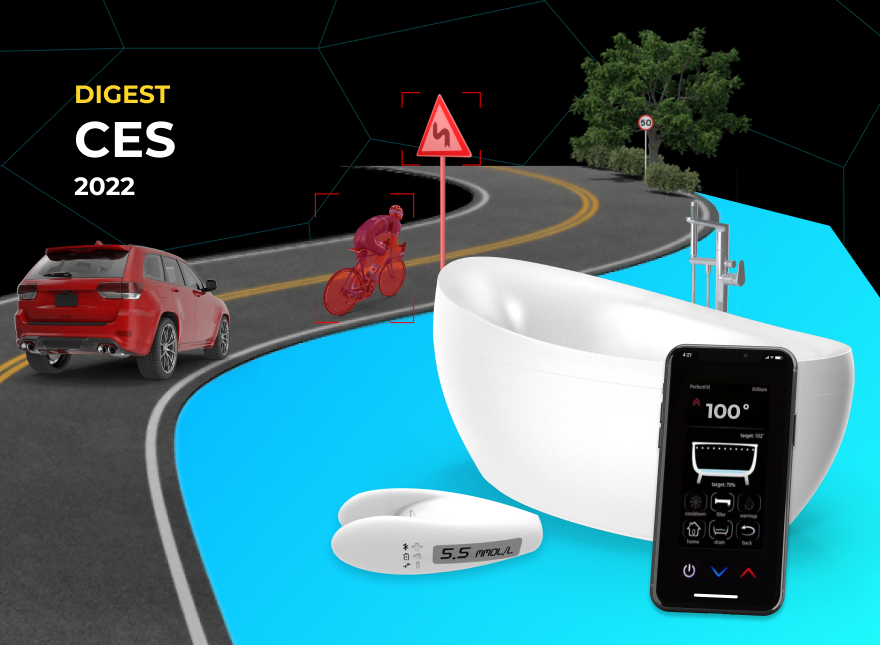Our Picks from CES 2022

Have you made it to CES this year? Well, our team has. We attended the largest electronics expo in-person to see big tech ideas becoming reality. Despite the pandemic, CES 2022 was back offline in Las Vegas. Some big tech names have decided to stay home, but over 2,300 other exhibitors demonstrated technologies that will drive the way we live, work, and do business in the future. Much of this revolved around the automotive, wellness, sustainability, and metaverse sectors.
Since then, our engineers have actively discussed solutions that were showcased at the event. We paid particular attention to one expo exhibitor which seemed especially innovative to us. It is an ADAS solution aimed to improve safety on roads in real time. Similarly, at Softeq, we also create ADAS products that increase safety by predicting dangerous situations on the road. As a result, we want to share our thoughts with you about this product and some other solutions that caught our eye.
Our Engineers’ Favorite: An ADAS Solution to Detect Multiple Objects on the Road
Our favorite belongs to an Austrian company EYYES building safety-critical assistance systems and AI-based products. At CES, EYYES presented their patented AI processing unit called Layer Processing Unit (LPU). It serves for object recognition, a critical component for reducing incidents on the road and increasing safety. Trained to recognize pedestrians, cyclists, cars, and other objects, it offers an extremely high recognition accuracy when compared to classic open source solutions.
We believe that the LPU is a kind of revolutionary concept because it can perform many computations simultaneously. In other words, the technology can detect multiple objects in real-time. The unit may benefit both startups and large enterprises seeking to introduce advanced safety solutions.
A Smart Non-Invasive Tool to Monitor Blood Glucose Level
About 422 million people worldwide have diabetes. It means that all these people should check their blood sugar numbers every day. Finger-prick glucometers are conventional, but they damage skin (and it hurts!). A Canadian AI company—Scanbo—wants to put an end to all that.
At CES, Scanbo introduced its prototype of a non-invasive glucometer. To estimate glucose level, the company uses photoplethysmogram and three electrodes for measuring heart data. It takes 60 seconds. Then, the raw data is analyzed by machine learning algorithms and the deep neural network to deliver the glucose level. Today, the device is aimed at glucose monitoring, but soon it will be able to do blood pressure measurements as well. Learn more about this alternative to some of the currently existing clinical techniques.
Sony’s Smart Electric Car to Deliver a Comfortable Mobility Experience
Gone are those days when electric vehicles were produced only by automotive manufacturers. Today, many tech giants are on their way to building their own electric cars. Sony is no exception.
On the CES stage, besides its existing Sony Vision-S sedan, the company showed off a brand-new model in the lineup, the Sony Vision-S SUV prototype. Built with safety in mind, the car has a total of 40 sensors installed inside and outside of the vehicle. They monitor every condition on the road and predict dangerous situations. The highest level of connectivity makes it possible to personalize the cabin for each user. Additionally, the vehicle is equipped with 5G. It results in high speed, high capacity and low-latency connectivity between the in-vehicle system and the cloud. Read on to learn more about Sony's SUV car.
A New Smart Home Tech to Have a Perfect Bath
It seems that 2022 could be the year of whole home interoperability. At CES, there were a lot of products aimed to create a smarter home rather than just a connected one. Some companies voiced an idea to make all connected devices in the smart home talk to each other, regardless of their manufacturers. Let’s take a look at one system that stole the CES show this year.
The system is called the Kohler PerfectFill. It’s a drain kit system and digital controller capable of integrating a tub into a smart home system. With a simple voice command, or via the linked Kohler Konnect app, the system fills up a perfect bath—a bath that's just right in temperature and depth. With the PerfectFill, no human monitoring is needed anymore, sensors will do the whole job.
